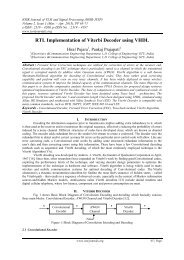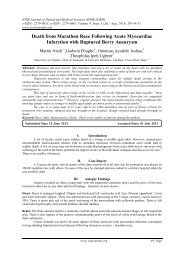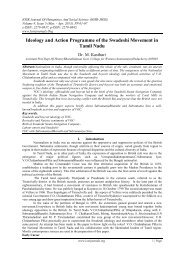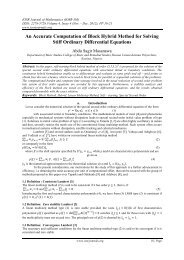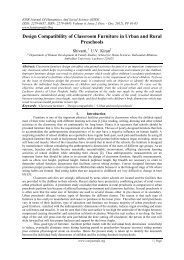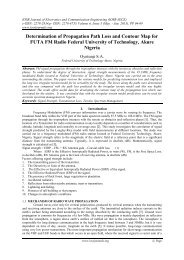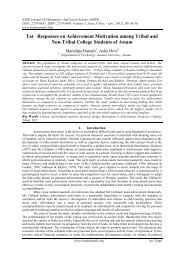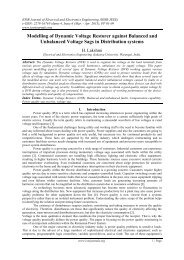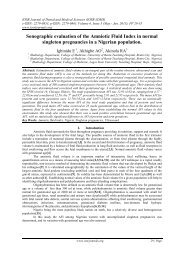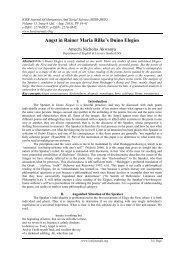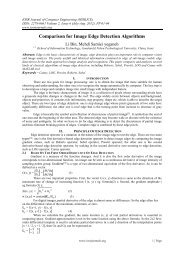Create successful ePaper yourself
Turn your PDF publications into a flip-book with our unique Google optimized e-Paper software.
<strong>Solar</strong> <strong>Cooker</strong><br />
sin(2( N(<br />
d ) 10))<br />
e(<br />
d)<br />
0.123cos( N(<br />
d)<br />
87) <br />
6<br />
T (2.6)<br />
( d)<br />
23.45cos( N(<br />
d)<br />
10)<br />
(2.7)<br />
<br />
N ( d)<br />
0.988 D(<br />
d)<br />
30.3( m 1)<br />
(2.8)<br />
<br />
GMT ( d ) represent the hours of rise and day sunset d; with = 1 for the sunset and = 1 for the rise. L the<br />
longitude is, ϕ is the latitude, Te(d) is the equation of time (in the hour), δ(d) is the declension (in degree). D (d)<br />
represent the day number in the month, m the number of the month ( January =1 ), and N ( d ) the day number<br />
in the year. (Fig.1.0)<br />
Model distribution of temperature<br />
This model uses the minimal ambient temperature Tmin ( d ) and maximal Tmax ( d ) (measured or<br />
estimated) for one day d to express the distribution, under sinusoidal shape, the ambient temperature T (d, t)<br />
during all day d:<br />
Tmax ( d ) T<br />
min<br />
( d ) Tmax ( d ) T<br />
min<br />
( d ) ( t 1)<br />
T ( d,<br />
t)<br />
<br />
<br />
sin( )<br />
2<br />
2<br />
12<br />
The time t is counted since the sunrise for the day d.<br />
All the sunbeams are focused in the center of the parabola.<br />
F - The focal length between the origin O and thefoyer F<br />
The summit of the parabola is O (Pic.1.1)<br />
Let M (Xo, Yo) a point situated on the parabola the tangeante M has for equation = ½ XOX / F - Yo. The<br />
normal M has for equation Y=-2xf / xo + 2f+yo<br />
U is in the middle of Oxo<br />
U is in the middle of TM<br />
O is in the middle of Tyo<br />
The parabola is a curve the equation of which is y = X 2 /4f (Fig.1.2)<br />
Equation of distribution of the heat in a homogeneous bar:<br />
2<br />
u<br />
k<br />
u<br />
<br />
t<br />
2<br />
cx<br />
With<br />
2<br />
a <br />
k<br />
c<br />
2<br />
u<br />
2 u<br />
a<br />
t<br />
2<br />
x<br />
(a is the coefficient of diffusivité thermal expressed in en m 2 .s –1 ).<br />
ρ : factor of reflection<br />
α : Factor of absorption or absorptivity<br />
τ : Factor of transmission or transmissivité<br />
we have naturally: ρ + α + τ: = 1<br />
Furthermore, any body which warms up emits in its environment a radiation of conversely proportional<br />
wavelength in its temperature. The law of Wien gives the wavelength of the maximum of emission, issue<br />
according to the body temperature<br />
After all, a thermal solar cell has to accept the maximum of sun rays (high transmittance), absorb the major part<br />
(high absorbance ), emit it and let take out the least possible (transmittance reduced in the long waves). [5], [6]<br />
Heat balance of a sensor<br />
The useful power is the one who allows to warm the debit of coolant m of the temperature of entrance<br />
Tentry until the temperature of exit Texit:<br />
Eu mcp ( T<br />
exit<br />
Tenttry )<br />
- E: the incidental solar power from the point of view of the sensor (W/m 2 )<br />
(2.9)<br />
www.iosrjournals.org<br />
14 | Page



